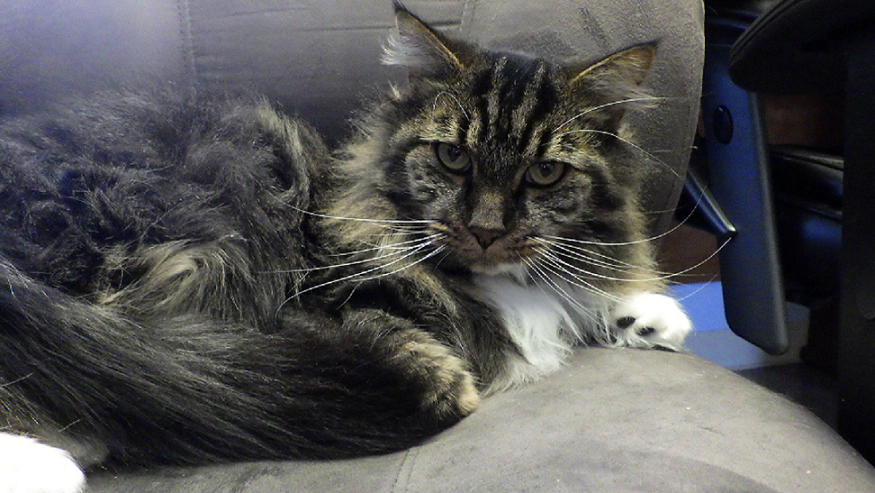
Ohh, I can’t believe I ate the whole thing! I’m headed for a tryptophan coma. Would you look at this food baby?
My oh my, you humans certainly have a lot of different ways to describe being full, or overfull, or stuffed. Kind of like your Thaksgiving turkey. I was listening to the chatter outside my little room, while I napped and  watched the snow fall down. I realized how lucky I am to have my ladies caring for me and watching how much and what kind of food I get. It seems that there is a malady that strikes unsuspecting pets around this time of year, dogs more often than cats, that can lead to some unpleasant consequences. I heard Dr Deb and Victoria talking about it, and ways to make sure that it happened as rarely as possible this year.
watched the snow fall down. I realized how lucky I am to have my ladies caring for me and watching how much and what kind of food I get. It seems that there is a malady that strikes unsuspecting pets around this time of year, dogs more often than cats, that can lead to some unpleasant consequences. I heard Dr Deb and Victoria talking about it, and ways to make sure that it happened as rarely as possible this year.
Apparently, Thanksgiving, Christmas, Haunukah, New Years, and the other winter celebrations can be rough on the digestive systems of family pets. There is a condition known as pancreatits that can be quite unpleasant for animals, as well as their humans. Pancreatitis is inflammation of the pancreas. The pancreas is an organ, which lies on the right side of the abdomen, alongside the intestines. It produces enzymes which assist in food digestion, as well as hormones like insulin which regulate blood sugar. Pancreatitis may be acute and mild or take on a more severe, hemorrhagic form. The associated inflammation allows digestive enzymes to spill into the abdomen and may result in peritonitis (inflammation of the peritoneum, the silk-like lining of the abdominal wall and covering the abdominal organs) and/or damage to other abdominal organs like the liver, gall bladder, and intestines.
Normally, pancr eatic enzymes are produced in an inactive state and travel into the duodenum (the first and smallest part of the small intestine, immediately beyond the stomach) where they are activated in order to start digestion. However, with pancreatitis, the enzymes are activated prematurely in the pancreas instead of waiting until they get to the small intestine. The enzymes begin digesting before they should and begin digesting the pancreas itself. This is the point at which most humans will notice something is a little bit off with their pets. What causes pancreatitis is kind of hard to pin down, especially in cats. Sometimes the cause is not known, but frequently dogs, and sometimes cats, will develop pancreatits after sneaking food, especially something with a lot of fat in it. That is why, it seems, the problem is worse during the holiday season – all that yummy food, just sitting there, begging to be eaten. And humans blissfully unaware of what we may be getting into. Muwahahahaha….
eatic enzymes are produced in an inactive state and travel into the duodenum (the first and smallest part of the small intestine, immediately beyond the stomach) where they are activated in order to start digestion. However, with pancreatitis, the enzymes are activated prematurely in the pancreas instead of waiting until they get to the small intestine. The enzymes begin digesting before they should and begin digesting the pancreas itself. This is the point at which most humans will notice something is a little bit off with their pets. What causes pancreatitis is kind of hard to pin down, especially in cats. Sometimes the cause is not known, but frequently dogs, and sometimes cats, will develop pancreatits after sneaking food, especially something with a lot of fat in it. That is why, it seems, the problem is worse during the holiday season – all that yummy food, just sitting there, begging to be eaten. And humans blissfully unaware of what we may be getting into. Muwahahahaha….
Pancreatitis does not play favorites. There is not a species or age that is more likely to suffer from it than another. If your furry friend is suffering from a pancreatic episode, you as their human can be on the look-ou t for nausea, vomiting, fever, lethargy, abdominal pain, diarrhea, and decreased appetite. Dogs may take on a “praying position” with their rear in the air, and their front legs and head lowered to the floor. In severe cases, depression, shock or death may occur. Medical shock, also known as circulatory shock, is brought on by a sudden drop in blood flow through the body, and interrupts the delivery of oxygen to vital organs.
t for nausea, vomiting, fever, lethargy, abdominal pain, diarrhea, and decreased appetite. Dogs may take on a “praying position” with their rear in the air, and their front legs and head lowered to the floor. In severe cases, depression, shock or death may occur. Medical shock, also known as circulatory shock, is brought on by a sudden drop in blood flow through the body, and interrupts the delivery of oxygen to vital organs.
Lab tests usually reveal an elevated white blood count though this may also be indicative of other conditions. Pancreatic enzymes may be elevated, which will confirm diagnosis. Many pets will have normal pancreatic enzymes. However there is a special new test which has had success in accurately diagnosing pancreatitis even when enzyme levels are normal. Radiographs may show changes associated with inflammation of the pancreas with severe hemorrhagic pancreatitis and Ultrasound may be helpful in showing inflammation in the pancreas and surrounding areas. Many animals will elude concrete detection with any testing and so diagnosis may be presumptive based on clinical signs and history.
Early diagnosis a nd prompt medical treatment goes a long way toward successful management of pancreatitis. In mild cases, treatment is simply supportive care and resting the digestive system and the pancreas, allowing the body to heal itself. The best way to rest the pancreas, and the only way to “turn it off”, is to withhold all oral fluids and food. The pancreas is given a break, and not required to secrete any digestive enzymes which could further injure the pancreas or surrounding organs. Intravenous fluids will be given to maintain normal fluid and electrolyte balance. Analgesics may be given for pain and anti-inflammatory medication will reduce inflammation of the pancreas and surrounding tissues. Sometimes anti-emetic and anti-diarrheal medications are given to control nausea, vomiting, and diarrhea. This also helps to slow fluid and electrolyte loss. Antibiotics may be given if an infection is also suspected. A pet may need to be kept in the hospital for several days so fluids and medications can be administered intravenously. Food will be gradually re-introduced. Intensive care may be required in cases of severe, hemorrhagic pancreatitis, or for animals showing signs of shock, so that aggressive fluid therapy and medications to counteract the shock can be given.
nd prompt medical treatment goes a long way toward successful management of pancreatitis. In mild cases, treatment is simply supportive care and resting the digestive system and the pancreas, allowing the body to heal itself. The best way to rest the pancreas, and the only way to “turn it off”, is to withhold all oral fluids and food. The pancreas is given a break, and not required to secrete any digestive enzymes which could further injure the pancreas or surrounding organs. Intravenous fluids will be given to maintain normal fluid and electrolyte balance. Analgesics may be given for pain and anti-inflammatory medication will reduce inflammation of the pancreas and surrounding tissues. Sometimes anti-emetic and anti-diarrheal medications are given to control nausea, vomiting, and diarrhea. This also helps to slow fluid and electrolyte loss. Antibiotics may be given if an infection is also suspected. A pet may need to be kept in the hospital for several days so fluids and medications can be administered intravenously. Food will be gradually re-introduced. Intensive care may be required in cases of severe, hemorrhagic pancreatitis, or for animals showing signs of shock, so that aggressive fluid therapy and medications to counteract the shock can be given.
A pet’s prognosis depends on the severity of the disease when it is diagnosed, as well as the response to therapy. A pet in the advanced stages, or animals in shock or showing signs of depression, are likely to have a guarded prognosis. However, with the more mild forms that are treated aggressively and in a timely manner a good outcome is highly probable. That is why it is so important for you to let your human know that something is amiss, even if you really, really don’t want to tell them what a naughty kitty or rascally pooch you have been to sneak away with their turkey or ham or the “piece de resistance”, that wonderful savory gravy.
are likely to have a guarded prognosis. However, with the more mild forms that are treated aggressively and in a timely manner a good outcome is highly probable. That is why it is so important for you to let your human know that something is amiss, even if you really, really don’t want to tell them what a naughty kitty or rascally pooch you have been to sneak away with their turkey or ham or the “piece de resistance”, that wonderful savory gravy.
So, you say. Okay. Great. If I do let my most base nature take over and give in to the tantalizing temptation of sneaking off with the bits of food no one will notice, am I doomed to a life of misery? Not necessarily. Most pets will recover without long-term issues. However, with severe or recurrent pancreatitis, if a significant number of cells that produce the digestive enzymes in the pancreas are destroyed, a lack of proper food digestion may result. This is a condition known as exocrine pancreatic insufficiency. It can be treated with daily enzyme tablets or powder. Alternately, if a significant number of insulin cells are destroyed, diabetes mellitus may occur, which will often be treated with daily insulin injections. Some pets will develop a more chronic form of pancreatitis, in which repeated bouts of illness that are difficult to diagnose may present as several days of poor appetite, fever, and lethargy. Lastly, and thankfully rarely, painful adhesions (fibrous bands of scar tissue that form between internal organs and tissues, joining them together abnormally) may develop between abdominal organs as a result of pancreatitis.
Quite frankly, after listening to Dr Deb and Victoria talk I vowed to never go near a human table again. Hold on, what’s that I smell? Oh, goodness. Here comes the turkey and gravy. Drat this base nature of mine. It’s a good thing these ladies are watching out for me. That’s is the only way I’ll survive the holidays!
Happy Thanksgiving.
